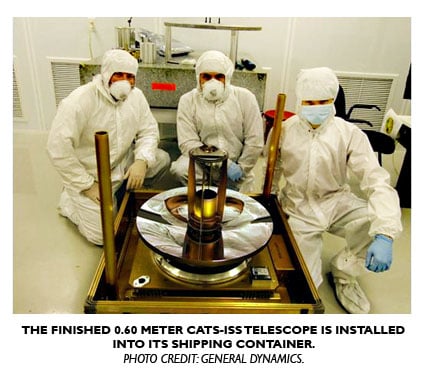Beryllium & Composites provided the I-220H beryllium and Precision Optics created the ultra-narrow bandpass filters in the receiver optics for two missions currently making news.
Space. The final frontier. Fellow Trekkies will excuse the homage, but this is an exciting time for Materion as a number of planned space missions using our materials are in the news. Customer General Dynamics used our hot isostatic pressed (HIP) instrument grade I-220H beryllium in the manufacture of two beryllium telescopes soon heading into space – the 0.60 meter CATS-ISS telescope and the 0.80 meter ATLAS ICESat-2 telescope. In addition, Precision Optics developed the enhanced microarray filter technology to enable more imaging data and higher image resolution in a smaller, more rugged package on these and most other NASA light detection and ranging (LiDAR) missions.  The Cloud-Aerosol Transport System (CATS) investigation uses a LiDAR system to measure the location, composition and distribution of pollution, dust, smoke, aerosols and other particulates in the atmosphere. CATS will be mounted on the Japanese Experiment Module's Exposed Facility on the International Space Station (ISS) in early December and will be used to study the atmospheric constituents that impact global climate. By gaining a better understanding of cloud and aerosol coverage, scientists can create a better model of the Earth's climate feedback processes.
The Cloud-Aerosol Transport System (CATS) investigation uses a LiDAR system to measure the location, composition and distribution of pollution, dust, smoke, aerosols and other particulates in the atmosphere. CATS will be mounted on the Japanese Experiment Module's Exposed Facility on the International Space Station (ISS) in early December and will be used to study the atmospheric constituents that impact global climate. By gaining a better understanding of cloud and aerosol coverage, scientists can create a better model of the Earth's climate feedback processes.
Last week, engineers and technicians at NASA's Goddard Space Flight Center in Greenbelt, Maryland, fitted the mirrored telescope of the Ice, Cloud and land Elevation Satellite-2 (ICESat-2) into its place. It's the latest milestone in the assembly of a satellite slated for launch in 2017 that will measure the elevation of Earth from space, helping scientists track changes to Earth's ice-covered poles, take stock of forests, map ocean surfaces and characterize clouds. ICESat-2's single instrument is the Advanced Topographic Laser Altimeter System, or ATLAS. Once in orbit, ATLAS will time how long it takes for light from its green lasers to travel to Earth's surface and back. By analyzing those times with computer programs and determining the distance light travels, scientists can calculate surface elevation.
Besides having key properties of low density, high elastic modulus and good thermal performance, beryllium mirrors are readily manufactured and can be directly fastened to matching beryllium structural elements to comprise compact, athermalized, and rugged designs for space launch and long term space operation.
Rob Michel, Market Manager for Space Applications, Beryllium & Composites added, “Materion has a long history of providing beryllium for NASA telescopes. Starting with the IRIS telescopes for Voyager in the 1960's, beryllium telescopes have been used in numerous space investigations. Properties such as their stiffness, low mass and good thermal performance has continued to make them attractive for space applications today."
Materion’s multispectral arrays enable sensing devices to be smaller and more powerful. A weather satellite might scan the earth’s atmosphere in 12 different wavelengths to track cloud development and use other wavelengths to measure solar and infrared energy to better understand climate processes.
Tom Mooney, Product Manager for Space, Precision Optics said, “Precision Optics is proud to have supported NASA LIDAR missions for over 25 years. These include both airborne and space flight missions for Earth, atmospheric and planetary science. Materion produces some of the highest performance ultra narrow bandpass filters available anywhere. They enable LIDAR and altimetry payloads developed not only at NASA but at the European Space Agency (ESA) and others.”
Previous space LIDAR systems employing beryllium telescopes and ultra-narrow bandpass filters include: GLAS (Geoscience Laser Altimeter System), MOLA (Mars Observer Laser Altimeter) and LOLA (Lunar Orbiting Laser Altimeter).
Dr. Edgar Vidal, Director of Business Development & Field Sales, Beryllium & Composites, concluded, “Materion continues to provide the critical materials like beryllium that are necessary for the success of space missions. With the incorporation of the metal matrix composite line of SupremEX and zirconium based Bulk Metallic Glasses in our portfolio, we expect that future space systems will include an even larger Materion footprint."
Learn more about CATS:
http://spacenews.com/41953earth-science-and-climate-monitoring-nasas-cats-ready-to-comb-the-clouds/
Learn more about ICESat-2:
http://m.phys.org/news/2014-11-nasa-lining-icesat-laser-catching-telescope.html